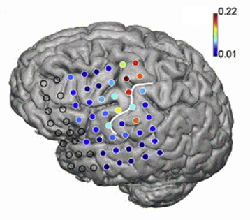
Patients with paralyzed or amputated hands are one step closer to recovering an essential ability: grasp.
Scientists can already use brain signals to control external devices such as prosthetic arms and hands. But many brain machine interfaces (BMIs) – methods for directing communication between the brain and the device – have limited capabilities.
In a recent study, published in NeuroImage, Northwestern Medicine scientists developed a method that can help people with severe paralysis regain grasping function.
“Most BMIs to date have concentrated on the position or velocity of the hand and fingers,” said Marc Slutzky, ’02 MD, ’00 PhD, ’06 GME, assistant professor in the Ken and Ruth Davee Department of Neurology, Physiology and Physical Medicine and Rehabilitation. [pullquote]“However, when trying to restore grasping, it is not sufficient to control the finger joint positions. When holding an object such as a hot cup of coffee, it is essential to grasp with the right amount of force to avoid dropping or crushing the cup.”[/pullquote]

BMIs interpret electric signals recorded from the brain. Traditionally using electrodes attached to the scalp or implanted in the brain, they bypass the injured part of the nervous system that causes paralysis.
Dr. Slutzky and his lab recorded signals from subjects using subdural electrodes, which are placed below the tissue covering the brain. Using these signals, they were able to decode the force and finger muscle activity levels that the subjects exerted while pinching a sensor between their thumb and index finger.
Subdural signals are less invasive than those implanted in the brain itself, and they may also be recorded for longer periods of time.
“This study showed that subdural signals provided a remarkable amount of information about grasp force and the underlying muscle activity during the grasp,” said Dr. Slutzky.
Ultimately, this information can be applied to BMI technology to help people paralyzed from neurological disorders such as stroke, spinal cord injury or amyotrophic lateral sclerosis (ALS) intuitively control grasp by stimulating their paralyzed muscles.
This study was supported by the Brain Research Foundation, the Northwestern Memorial Foundation Dixon Translational Research Grant Program, Paralyzed Veterans of America grant 2728, Doris Duke Charitable Foundation Clinical Scientist Development Award 2011039, National Science Foundation award 1134575 and the American Brain Foundation.






